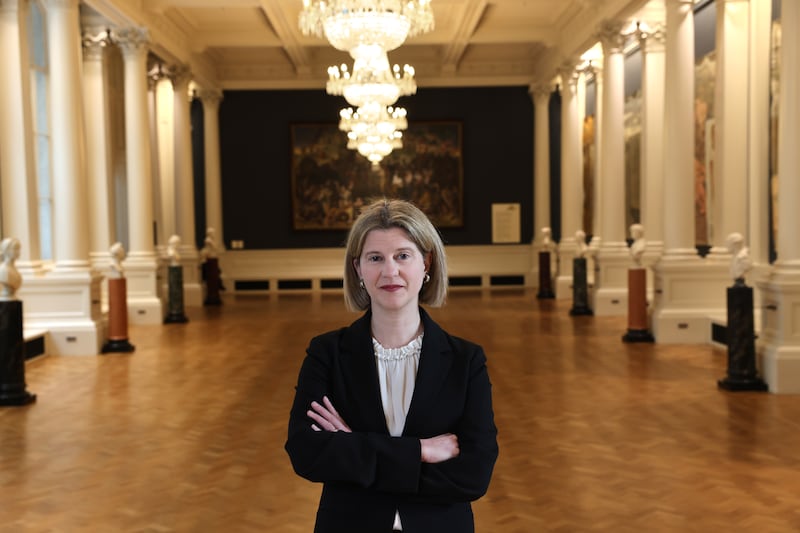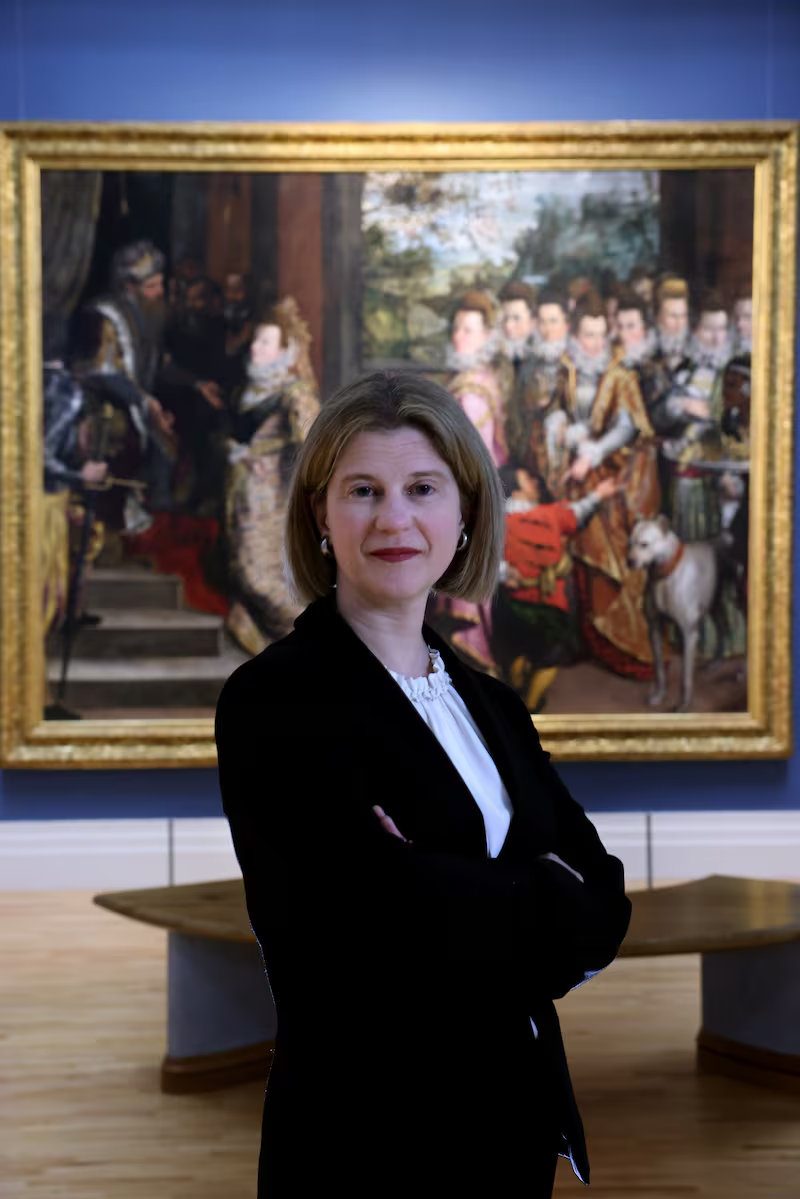Roughly 100 years since a small number of Irish women emerged as the dominant exponents of a modernist and modernising impetus in Irish art and design, the National Gallery of Ireland (NGI) has appointed its first woman director.
Caroline Campbell took up her post quietly at the end of 2022. Originally from Belfast, she was based in London where she worked at the National Gallery. Her predecessor, Sean Rainbird, served two consecutive terms as director, during which he oversaw a big part of an extensive refurbishment and enhancement of the building complex, considerably broadened the gallery’s artistic reach, and guided the institution through the choppy waters of the covid pandemic, which largely stalled progress and opportunities on a number of fronts.
Campbell, who is in person attentive, soft-spoken and understated, said she was absolutely delighted when originally approached about the directorship. While it is her first time at the helm of an institution, she was well established in one of the world’s premier galleries as director of collections and research and has a sterling track record in curatorial achievement. Her book Power, People and Painting, an enlivening tour of western art history through the prism of 15 cities at crucial moments, will be published later this year. While she is, as she notes, a specialist in the early Renaissance, her interest and curiosity (and one could add expertise) extend a great deal further.
She takes over the gallery at a challenging time: museums globally now compete with the digital world, even as they reap some of its benefits in the areas of publicity and communications; they must reassess their role and address pressing questions around redefining the canon, equitable representation and audience engagement (in relation to which, bringing in the young audience counts as perhaps the biggest task). All in all, Campbell might have been content to stay where she was. But she is clearly enthusiastic – excited, she says – about her new job and, as she is quick to point out, the gallery has a special place in her heart.
READ MORE
Born in Belfast, she grew up during the Troubles. Her father was a cardiologist and her mother, who worked at the Linenhall Library, had a keen interest in art. Travel out of Northern Ireland was a revelation, and slightly unsettling. “I was shocked at the lack of guns and security in general. I actually felt a little unsafe. It took a while to get used to the idea that none of that was needed.” A visit to Dublin’s National Gallery was eye-opening partly because of the relaxed ambience.
Primarily, though, the sheer emotional power of paintings she saw impressed her. She was struck by Jack B Yeats and, especially, John Lavery’s vast painting The Artist’s Studio, featuring Hazel Lavery, her daughter and stepdaughter in his palatial London studio. “I was unaware when I first saw it that he was echoing Velázquez’s great painting Las Meninas. I just responded to it on its own terms.”
It may have been on that or one of many subsequent visits that she acquired a postcard of the Lavery, one of several that she kept with her, pinned to various walls, through her student years: “I still have them now, though they are rather the worse for wear at this stage.” Paul Henry’s view of Killary Harbour at dawn, from the Ulster Museum, was also among this group of talismanic cards.

Her third-level studies began with modern history at Oxford, where, she says, she had a great time. “History is a brilliant subject to study because it can lead in so many directions.” When she arrived there she wasn’t, she admits, entirely aware that art history was a potential subject in its own right, but her interest in art became increasingly focused and led to her working as an assistant in the print rooms at the Ashmolean; she graduated to being print room supervisor. The range of the collection there was an education in itself, consolidating her sense of the connections across places and eras in art.
She went to the National Gallery London as a curatorial assistant on a temporary contract: “They were very kind people, keen to give young curators opportunities.” Gaining valuable experience working on big exhibitions, she later returned to the National Gallery as curator of Early Renaissance paintings. In the meantime, she also flourished at the Courtauld, as both student and curator, completing an MA and a PhD and serving as curator of paintings.
It’s a resource for visitors but also for the whole island and I’m very much behind efforts to make it accessible outside of Dublin
— Caroline Campbell
A fellowship year at New York’s Centre for Curatorial Leadership under its director Elizabeth Easton was also important: “Each fellow shadows a museum director somewhere in the world. You meet many people and learn a lot.” It sounds demanding? She nods. “But rewarding.” The leadership referred to, she emphasises, is about collaboration, rather than telling people what to do. “The curatorial process is dependent on communicating with other people from start to finish. You can’t accomplish anything without collaboration. And you find people always have a lot to contribute, they have so much to offer.”
Her PhD focused on one, relatively neglected aspect of the Courtauld’s remarkable collection: Cassoni. It sounds like a niche subject, but accords perfectly with her sense of art as being first a vitally personal experience. Cassoni are paired wedding chests, extraordinary objects elaborately embellished with decorative precious metals, and with paintings, usually on classical themes, marking the union of two families in Renaissance Florence. “Some of the best Renaissance paintings were made for private spaces rather than as grand public statements,” Campbell notes.
She has a number of priorities at the NGI. “I love that the gallery is in the centre of the city. I’ve always felt that it is connected to the life of the city.” And she is aware that the gallery is regarded with real, proprietorial affection by Dubliners, and by the general Irish population.
It’s clear that she finds the experience of visiting museums and seeing paintings deeply rewarding (she’s just been to see the Vermeer in the Rijksmuseum, which includes our own very fine Vermeer, and describes the exhibition as overwhelming), and she is keen to afford that opportunity to as many people as possible. “The gallery should be accessible and enjoyable for everyone... I mean everyone, from age seven upwards.” The collection she regards as wonderful. “The combination and interaction of the Irish and the international excites me, and it is unique. It’s a resource for visitors but also for the whole island and I’m very much behind efforts to make it accessible outside of Dublin.”
She’d like the collection to have a higher profile abroad, especially given the general goodwill towards the gallery as an institution. As for bringing works from abroad for temporary exhibition, while aware that moving valuable artworks is increasingly difficult and expensive, she points out that the gallery is very well networked and: “There’s huge potential for working with what we have.” Overall, “As I see it, the gallery is in a good place.”

Rather than viewing digital technology as a rival or a threat, she is optimistic that, far from replacing a visit to the gallery, technology can enhance it. “I remember during Covid sitting in my bedroom delivering a lecture online and thinking how extraordinary it was to be able to do that.” The digital realm, she is certain, has a powerful role to play in education, and education is essential to the gallery’s future, not least in winning over that young audience. She alludes to its strong reputation in engagement with schools and its programmes of lectures and workshops. “You have to work to bring people to art.”
Diversifying historical representation is obviously one current priority. While traditionally there’s been sporadic debate about the logical cut-off point in time for the gallery’s collection, her view echoes that of Rainbird’s in preferring not to have any defined cut-off point. A 2022 acquisition, James Coleman’s Still Life 2013-2016 (on view in the Hugh Lane Room) is a case in point. And a summer exhibition in the Print Gallery, Shelter, juxtaposes works from the collection with new pieces by five contemporary woman artists.
You need flexibility, Campbell argues: “You’ve got to keep the gallery as a vital space.” Part of that vitality relates to building the collection, which has never been easy, financially, and has sometimes been next to impossible, as the art market boomed. “It’s challenging, but there are examples of past acquisitions that show how it can be done, the Van Gogh of rooftops in Paris, for example, which is a terrific painting. You can buy in that kind of clever, oblique way, bypassing conspicuous or obvious works.”
Not that the historical is being neglected. She points to the upcoming summer highlight, Lavinia Fontana: Trailblazer, Rule Breaker, a keenly anticipated celebration of the pioneering late 16th-century Bolognese artist. In the autumn, Campbell points to Lavery, On Location, a collaboration with National Museums NI and the National Galleries of Scotland. The exhibition highlights Lavery the landscape artist, often overlooked given the emphasis on his portraits.
Throughout her career so far, and now, she sees her Belfast background, positioning her, she found at Oxford, as both Irish and British, as being an advantage, offering her a distinctive, dual, inclusive perspective on the world which is – she cites Louis MacNeice – “incorrigibly plural”. She likes that plurality, “the drunkenness”, as he puts it, “of things being various”.



















